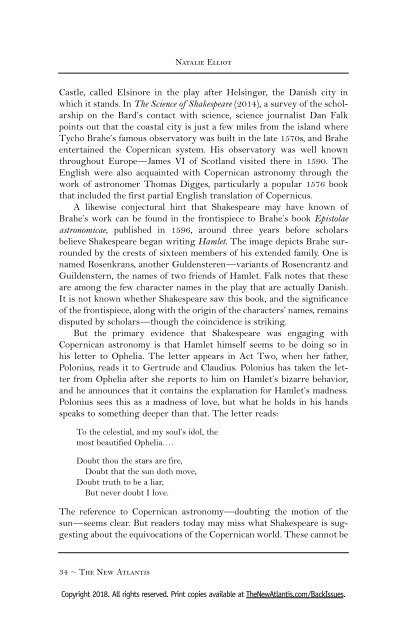The New Atlantis - Winter 2018 (Issue 54) uncompressed with cover
You also want an ePaper? Increase the reach of your titles
YUMPU automatically turns print PDFs into web optimized ePapers that Google loves.
Natalie Elliot<br />
Castle, called Elsinore in the play after Helsingør, the Danish city in<br />
which it stands. In <strong>The</strong> Science of Shakespeare (2014), a survey of the scholarship<br />
on the Bard’s contact <strong>with</strong> science, science journalist Dan Falk<br />
points out that the coastal city is just a few miles from the island where<br />
Tycho Brahe’s famous observatory was built in the late 1570s, and Brahe<br />
entertained the Copernican system. His observatory was well known<br />
throughout Europe — James VI of Scotland visited there in 1590. <strong>The</strong><br />
English were also acquainted <strong>with</strong> Copernican astronomy through the<br />
work of astronomer Thomas Digges, particularly a popular 1576 book<br />
that included the first partial English translation of Copernicus.<br />
A likewise conjectural hint that Shakespeare may have known of<br />
Brahe’s work can be found in the frontispiece to Brahe’s book Epistolae<br />
astronomicae, published in 1596, around three years before scholars<br />
believe Shakespeare began writing Hamlet. <strong>The</strong> image depicts Brahe surrounded<br />
by the crests of sixteen members of his extended family. One is<br />
named Rosenkrans, another Guldensteren — variants of Rosencrantz and<br />
Guildenstern, the names of two friends of Hamlet. Falk notes that these<br />
are among the few character names in the play that are actually Danish.<br />
It is not known whether Shakespeare saw this book, and the significance<br />
of the frontispiece, along <strong>with</strong> the origin of the characters’ names, remains<br />
disputed by scholars — though the coincidence is striking.<br />
But the primary evidence that Shakespeare was engaging <strong>with</strong><br />
Copernican astronomy is that Hamlet himself seems to be doing so in<br />
his letter to Ophelia. <strong>The</strong> letter appears in Act Two, when her father,<br />
Polonius, reads it to Gertrude and Claudius. Polonius has taken the letter<br />
from Ophelia after she reports to him on Hamlet’s bizarre behavior,<br />
and he announces that it contains the explanation for Hamlet’s madness.<br />
Polonius sees this as a madness of love, but what he holds in his hands<br />
speaks to something deeper than that. <strong>The</strong> letter reads:<br />
To the celestial, and my soul’s idol, the<br />
most beautified Ophelia....<br />
Doubt thou the stars are fire,<br />
Doubt that the sun doth move,<br />
Doubt truth to be a liar,<br />
But never doubt I love.<br />
<strong>The</strong> reference to Copernican astronomy — doubting the motion of the<br />
sun — seems clear. But readers today may miss what Shakespeare is suggesting<br />
about the equivocations of the Copernican world. <strong>The</strong>se cannot be<br />
34 ~ <strong>The</strong> <strong>New</strong> <strong>Atlantis</strong><br />
Copyright <strong>2018</strong>. All rights reserved. Print copies available at <strong>The</strong><strong>New</strong><strong>Atlantis</strong>.com/Back<strong>Issue</strong>s.


